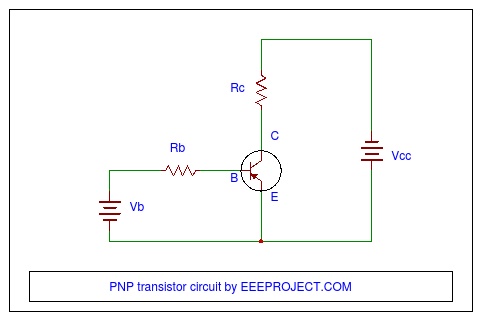PNP Transistor
PNP transistor is the types of bipolar junction transistor. In PNP transistor, PNP stands for Positive-Negative-Positive configuration. So, basically in this type of transistor two p-type (positive) materials dope a single n-type (positive) material and the PNP configuration is established, and it is referred to as a PNP transistor.
It is a device which is controlled by current. There are different types of transistors, for example NPN transistor is also an example of Bipolar Junction Transistor (BPT).

Components of a PNP Transistor
It is a device in which two p-regions together sandwich one n-region and gives us two pn junctions.
The PNP transistor is divided into three distinct regions that are p-type, n-type and p-type.
And, the two pn junctions formed in this transistor are as follows:
- Emitter-Base junction: It is a junction where the positive doped emitter meets with the base that is a negative region. It is represented by ‘EB’ and has an ‘Emitter’ and an ‘Emitter region’ just next to the ‘Base region’.
- Collector-Base junction: It is a junction where the positive doped collector meets with the base region (B) that is highly negative. It is represented by ‘CB’. It also has a ‘Collector’ region which is highly positive just next to the negative ‘Base region’ (B).
So, basically PNP transistor is a combination of two diodes which are connected back to back.
- The left one is the Emitter-Base diode (EB).
- And, the right one is the Collector-Base diode (CB).
The major types of current carriers in these types of transistors are holes. And, the minor current carriers are electrons. And, in these transistors all the voltage polarities are reversed, because in this current sinks in to the base region. That’s what makes PNP transistor a current-controlled device.
Bipolar Junction Transistors (BJT) always has its arrow in the emitter region which basically shows the direction of flow of the conventional current.
Working of a PNP Transistor
- For turning on the PNP transistor, you need to make sure that the voltage present on the base is lower than that of the terminal.
- When it is turned on, then the current starts flowing from the Emitter-base region towards the base region and then finally to the collector.
- For a PNP transistor, an emitter only operates if the base voltage is more negative than it.
- This is must for an emitter-base junction to act as a diode.
- So, the base region actually works as the input and both the emitter and collector regions as output.
- Because, it is the base region that controls the small amounts of current flow which then controls large amounts of current flow in the emitter and then to the collector region.
- The emitter region is connected to a voltage supply and the collector region is connected to the load resistor.
- And, another resistor is connected to the base region and also a negative voltage supply is provided to the base region.
- Load resistor is joined in the circuit of PNP transistors to limit the current flow through the circuit.
- The characteristic curve of this bipolar junction transistor rotates at 180 degree.
- And, PNP transistors can also be used as a type of switch.
Application of PNP Transistor
- They are used as switches.
- They are used for conducting current in heavy motors.
- Amplifying circuits also have PNP transistors in them.
- The use of these transistors is also made in robotic applications.
